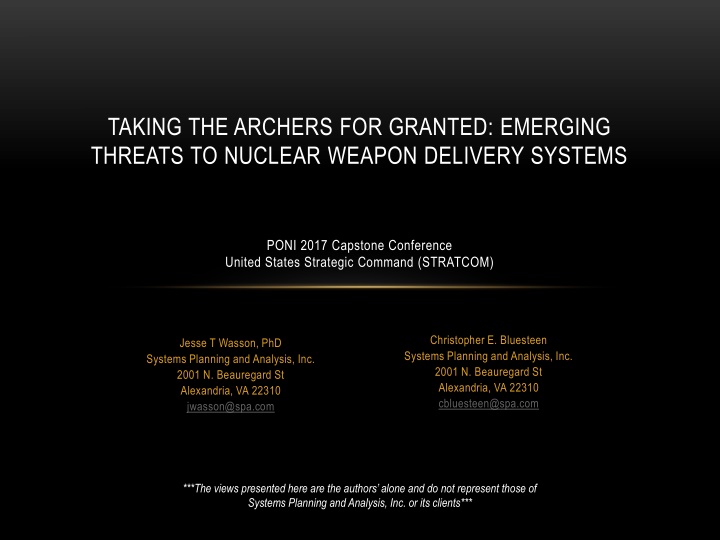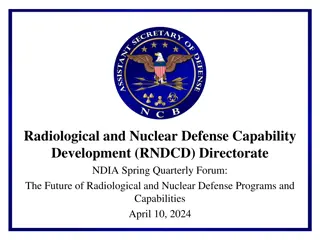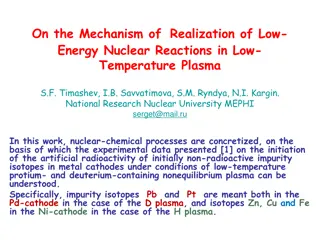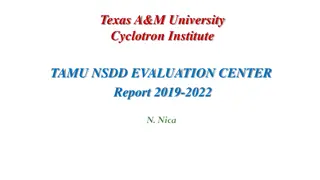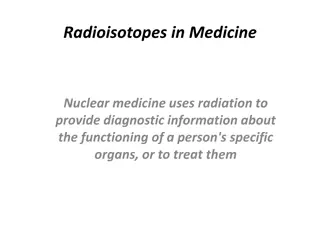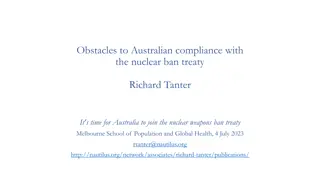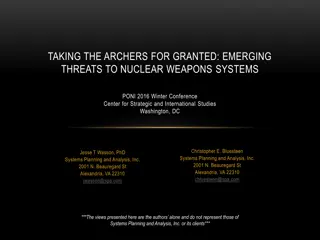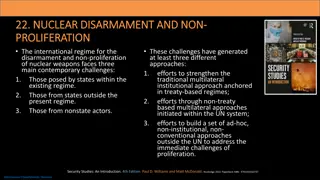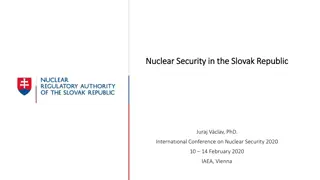Emerging Threats to Nuclear Weapon Delivery Systems
By exploring the potential vulnerabilities in the F-35 program and the intersection of nuclear weapons and cybersecurity, this content delves into the critical importance of reliable delivery systems in maintaining global security and deterrence.
Download Presentation

Please find below an Image/Link to download the presentation.
The content on the website is provided AS IS for your information and personal use only. It may not be sold, licensed, or shared on other websites without obtaining consent from the author.If you encounter any issues during the download, it is possible that the publisher has removed the file from their server.
You are allowed to download the files provided on this website for personal or commercial use, subject to the condition that they are used lawfully. All files are the property of their respective owners.
The content on the website is provided AS IS for your information and personal use only. It may not be sold, licensed, or shared on other websites without obtaining consent from the author.
E N D
Presentation Transcript
TAKING THE ARCHERS FOR GRANTED: EMERGING THREATS TO NUCLEAR WEAPON DELIVERY SYSTEMS PONI 2017 Capstone Conference United States Strategic Command (STRATCOM) Christopher E. Bluesteen Systems Planning and Analysis, Inc. 2001 N. Beauregard St Alexandria, VA 22310 cbluesteen@spa.com Jesse T Wasson, PhD Systems Planning and Analysis, Inc. 2001 N. Beauregard St Alexandria, VA 22310 jwasson@spa.com ***The views presented here are the authors alone and do not represent those of Systems Planning and Analysis, Inc. or its clients***
A QUICK THOUGHT EXPERIMENT By 2024 the F-35A variant of Lockheed Martin s F-35 Lighting II is expected to be certified to carry nuclear weapons According to recent GAO and DoD DOT&E reports the program has experienced serious software problems raising doubts about this timeline Imagine for a minute that these problems were not self-inflicted. Imagine they were caused by a state actor intending to either compromise one or an entire F-35 variant Why would an adversary do this? Would they get caught? Would they want to get caught? What would be the consequences? How long and at what cost would it take the U.S. to remedy? Would this cause the U.S. and allies to have less confidence in the reliability of its deterrent? What if a submarine or missile silo also experienced weapon system failures? Could this alter U.S. foreign policy decisions? 2
NUCLEAR WEAPONS & CYBERSECURITY Current views on this issue tend to fall into one of three camps: Anything is possible Unhackable Don t know Most of this work is either explicitly or implicitly focused on nuclear command and control Scenarios short of crisis and attacks that do not endanger a state s second strike capability or justify a military response are absent No formal treatment of this issue in the literature Far more research and strategic thought needed, particularly in the area of delivery systems 3
WHY DELIVERY SYSTEMS? The arrows are useless without the archers In the absence of nuclear weapons tests, the perceived effectiveness of the deterrent is solely a function of the perceived effectiveness of the delivery systems Large attack surface: ballistic missiles, cruise missiles, submarines, fighters, bombers, and road-mobile platforms Less of an air gap than the actual weapons Numerous modernization efforts underway Conversions from analog to digital technology Greater networking of horizontal and vertical systems Reliance on commercial off-the-shelf (COTS) components and distributed supply chains Need for more frequent software / firmware updates Cybersecurity of DoD weapon systems questioned 4
Our present acquisition-based strategy is unsustainable Now is the opportunity to develop a long-term approach that addresses homeland missile defense and regional missile defense priorities a holistic approach incorporating left-of-launch and other non-kinetic means of defense. -Adm Greenert & Gen Odierno, 2014 EMERGING THREATS Left-of-launch missile defense Greenert/Odierno memo Kinetic vs. non-kinetic Intersection of left-of-launch missile defense and non-kinetic methods presents a mounting danger Previous cyber operations against nuclear weapon production facilities Olympic Games Alleged DPRK campaign Source: GAO, Missile Defense: Opportunity to Refocus on Strengthening Acquisition Management, 2013 The threat originally manifested itself in 1944 with the V-2. The allies had no way to intercept the world s first ballistic missile, they had to get left of launch. They had to go after the manufacturing facilities and the launchers. -Adm Gortney, Breaking Defense 2015 5
REASON TO WORRY Strategic Unrest Global and regional power struggles Growing offensive and defensive disparities in nuclear capabilities Rise of hybrid warfare Appeal of non-kinetic left-of launch attacks on nuclear weapon delivery systems Less risky than attacks on command and control More versatile than kinetic missile defense Victim s perception of effects likely to be far greater than actual effects Relatively cost-effective depending on objective 6
SOME NOTIONAL SCENARIOS Defense: Country X seeks to protect their cities by deterring or mitigating counter-value threats posed by a rogue state. Because of the expense and ineffectiveness of traditional ballistic missile defense they develop a non-kinetic left-of-launch capability. Country X either then reveals this capability (anonymously or not) during peacetime by causing a missile test to fail hoping their opponent will then change their behavior, or they keep it dormant until a launch is imminent Hybrid Warfare: Country Y fears they can no longer maintain a secure second strike capability vis- - vis another major power. To attrite counter-force threats they develop a non-kinetic left-of-launch missile defense capability and use it anonymously during peace time to cause adversary weapon system tests to fail. Alternatively, they use it during a crisis to show fallibility of adversary s deterrent and compel restraint Nuclear War: Country Z develops non-kinetic left-of-launch capability in preparation for possible nuclear war with regional rival. Should conflict escalate, they use it to enable a counterforce first strike attack in combination with traditional ballistic missile defense, anti-submarine warfare, strategic weapons, etc. 7
MODELING DETERRENCE STABILITY Left-of-launch non-kinetic operations against nuclear weapon delivery systems have not been formally studied in the literature Conceptual parallel with traditional missile defense models But there remain important differences to account for such as the covert nature, opaqueness, attribution challenges, and versatility of non-kinetic left-of-launch missile defense Generalized Mutual Deterrence Game (GMDG) developed by Zagare and Kilgour (2004) used for our analysis Summary of findings: Asymmetric (one-sided) development is destabilizing except in very limited cases Mutual development may be stabilizing provided its balanced and both sides exaggerate the effectiveness of the other s capability Development paths are likely to be uneven and uncertain though, leading to greater instability in the interim 8
STRATEGIC POLICY IMPLICATIONS Non-kinetic left-of-launch missile defense is no longer fantasy More careful thought is needed regarding deterrence and its relationship to emerging missile defense technologies Military leaders and policy makers must understand how these defensive capabilities can undermine the larger deterrence mission There is significant risk of further aggravating existing nuclear arms race pressures and fears of preemptive war Resolving this security trilemma is made difficult by the level of secrecy surrounding left-of-launch capabilities and OCOs Greater transparency is warranted, and perhaps arms control agreements regulating these types of capabilities among nuclear powers 9
SECURITY POLICY IMPLICATIONS Re-think the purpose of U.S. nuclear weapons security DoD nuclear weapons security policy is centered on the principal of access denial with billions of dollars spent since 9/11 to improve the physical protection of U.S. weapons Greater attention must be paid to ensuring the strategic force can meet its deterrence mission Re-think cybersecurity and what it means for the U.S. nuclear deterrent Information assurance controls are largely aimed at mitigating known technical vulnerabilities Advanced state actors sure to employ zero-day vulnerabilities, custom malware, social engineering, supply chain exploits, and insiders Red team performance-based approaches are required in addition to compliance-based checklists Re-think design of U.S. delivery systems Maintaining nuclear triad is probably more important now than ever before Modernization efforts though bring strong incentives to adopt more integrated and complex technology Advantages need to be weighed against mission risks early in the design process 10
